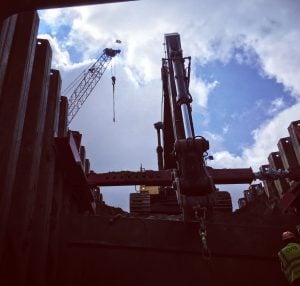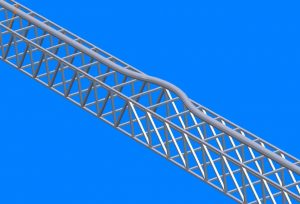There are two criteria that predict the safety of a scaffold platform. One of the criteria involves the engineering properties of the scaffold unit. The other criterion addresses the correct installation of the platform. Correct installation includes proper support, correct positioning to limit spaces between platform units, and the minimum width of the platform.
The Federal Occupational Safety and Health Administration, OSHA, and other agencies, set forth the minimum standards for the installation and use of platform units. For example, regulations address the minimum and maximum overhang of platform units, the allowable deflection, the space between units, and the distance from the edge of the platform to the work surface and the guardrail system. These regulations are in the subsection on platforms, 29CFR1926.451(b), and are quite specific. The regulations address all platforms, including solid sawn wood plank, laminated veneer lumber (lvl), metal fabricated decks, and platforms constructed of structural members and sheathing such as plywood. These specific regulations ensure that the platform you construct will stay on the scaffold, will be large enough so you won’t fall off the platform, and won’t have any openings that you may fall through.
Engineering properties also predict the safety of the platform. For manufactured platforms, such as aluminum decks and laminated veneer lumber, the manufacturer indicates the capacity of the product. For solid sawn plank, determining the capacity is not as straightforward due to varying factors. These factors include the dimensions of the plank, the specie of tree, what part of the tree is being used, and if the wood has any damage. How in the world do you determine if the plank is strong enough? Fortunately, you have help! Qualified engineers can determine the strength of the plank you are using if the dimensions, the specie of tree, and the quality of the wood are known. The engineer will also need to know the span of the plank, that is, the distance between supports. While you can give the engineer the dimensions and span of the plank, the type and quality of the wood is another story. Unless you cut the tree down yourself, you probably won’t be able to tell if the wood is pine or poplar. And unless you have learned how to grade lumber, you won’t know if the wood is any good.
How, then, is the grade of the wood determined? Qualified, trained lumber graders are one method used by lumber mills to determine the strength of wood. These individuals are trained to determine the various strengths of wood that will come from a tree. Factors used to determine strength include such things as density (how many rings per inch), the straightness of the grain, and the frequency of knots. Straighter grain, higher density, and fewer knots will result in a strong piece of wood. On the other hand, frequent knots and low density will result in a low strength piece of wood.
The engineer relies on the ability of the grader to do his or her job correctly. The engineer also relies on the accuracy of the stamp to determine precise information for you to use. The bottom line here is that the information in the grade stamp dictates the accuracy of the engineer’s calculations. Of course, this information will only be accurate if the plank you use has been graded by a qualified grader, using recognized standards. If the wood is not as good as the grade stamp indicates disaster will surely follow.
For typical situations, it is recommended that only Scaffold Grade plank be used since this will enhance safety on your scaffold project. Scaffold Grade plank is a very specific grade of lumber that has a very high strength compared to other commonly found lumber on a construction project. However, if you choose to use a plank other than scaffold grade, it must be engineered for proper use. This is the only way you will be safe and in compliance with the regulations.
Do not take chances with solid sawn wood plank. A grade stamp from a recognized grading agency is your guarantee of accuracy. High strength lumber is not cheap. Neither is a worker’s life. If the board breaks, there is no back-up.













